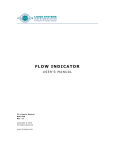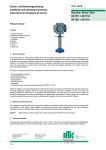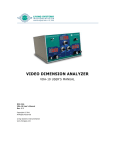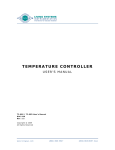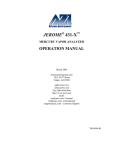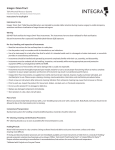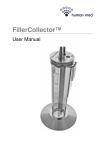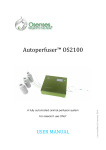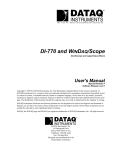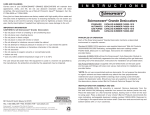Download PERFUSION PRESSURE MONITOR
Transcript
PERFUSION PRESSURE MONITOR USER’S MANUAL DOC-237 PM-4 User’s Manual Rev. 1.1 Copyright © 2011 All Rights Reserved Living Systems Instrumentation www.livingsys.com LIVING SYSTEMS INSTRUMENTATION PM-4 PRESSURE MONITOR THIS PAGE INTENTIONALLY LEFT BLANK - ii - LIVING SYSTEMS INSTRUMENTATION PM-4 PRESSURE MONITOR TABLE OF CONTENTS Chapter 1 .............................................................................................. 1 Introduction ...................................................................................................... 1 System Components ........................................................................................ 1 Definition of Terms ......................................................................................... 1 Chapter 2 .............................................................................................. 2 Hardware Overview ............................................................................................ 2 Front Panel .................................................................................................... 2 Rear Panel ..................................................................................................... 3 Chapter 3 .............................................................................................. 4 Transducer Calibration ........................................................................................ 4 Chapter 4 .............................................................................................. 7 Operating Instructions ........................................................................................ 7 Plumbing Connections ...................................................................................... 7 Transducer Connections ................................................................................... 8 Transducer Connections with a PS-200 ............................................................... 8 Chapter 5 ............................................................................................ 10 Notes and Tips ................................................................................................ 10 Pressure Transducers .................................................................................... 10 Specifications ............................................................................................... 10 Living Systems Contact Information ................................................................. 11 - iii - LIVING SYSTEMS INSTRUMENTATION PM-4 PRESSURE MONITOR CHAPTER 1 Introduction The PM-4 Perfusion Pressure Monitor is designed to monitor and record two physiological pressures in the range of 0 to 200 mmHg, as well as their difference, and their average. It is ideally suited for studies of isolated vessels that are cannulated and perfused; for example using Living System's Vessel Chambers where one transducer is located proximal to the vessel and the other distal. Using this configuration, the differential pressure is a measure of the perfusion pressure, giving rise to flow, or as a consequence of imposed flow. Also, the average pressure represents the mean vessel pressure when the flow resistances of the two cannulae are similar. Changes in the caliber of the vessel during a perfusion experiment will usually result in an alteration of the pressures. The transducers may also be located in different branches of an isolated perfused vascular bed, or organ, to provide pressure information, or to measure pressures at two transducer locations in the absence of flow. System Components • PM-4 Pressure Monitor • Two flow-thru solid state pressure transducers with extension cables for connection to the PM-4. • Four BNC-BNC shielded cables for recording the pressures: P1, P2, dP (i.e., (P1-P2)), and P AV (i.e., (P1+P2)/2)). • Power Cord (117 VAC or 230 VAC). Definition of Terms P1: The pressure as sensed by pressure transducer P1. P2: The pressure as sensed by pressure transducer P2. dP: The differential pressure, or the difference between P1 and P2. P AV : The (mean) average pressure of P1 and P2. -1- LIVING SYSTEMS INSTRUMENTATION PM-4 PRESSURE MONITOR CHAPTER 2 Hardware Overview Front Panel Figure 2-1 – PM-4 Front Panel Power Switch: Toggle switch to turn the PM-4 ON and OFF. Display: Displays the value of the pressure reading that has been selected using the Display Control Knob. Display Control Knob: The display control knob allows the user to select which pressure reading to display; P AV , dP, P2 or P1. Adjustment Potentiometers: The adjustment potentiometers allow the user to adjust the zero pressure reading (ZERO) and calibrate (SCALE) both P1 and P2. -2- LIVING SYSTEMS INSTRUMENTATION PM-4 PRESSURE MONITOR Rear Panel Figure 2-2 - PM-4 Back Panel Outputs: Four BNC analog output voltage jacks (BNC) provide 10mV/mmHg signals for simultaneous recordings of P1, P2, dP and P AV . Transducer Inputs: P1 and P2 refer to the telephone style jacks for the pressure transducers A/C Power: Connector for the line cord. -3- LIVING SYSTEMS INSTRUMENTATION PM-4 PRESSURE MONITOR CHAPTER 3 Transducer Calibration It is important to note that changes in the temperature of the transducer will affect the calibration. If this is critical, the following calibration procedure should be performed with a heating lamp, which will raise the temperature of the transducers to approximately that of the warm solution that flows through the transducers during a procedure. Figure 3-1 - Transducer Calibration Hardware Configuration Connect the hardware as shown above, in Figure 3-1. 1. Connect the P1 transducer cable to the P1 jack on the back of the PM-4. 2. Connect the P2 transducer cable to the P2 jack on the back of the PM-4. 3. Set the Display Control Knob on the front of the PM-4 to P1. 4. Open the stopcocks to air and release all pressure in the manometer so that it reads 0.00. 5. The Display on the front of the PM-4 should read 0.0. If it doesn’t, adjust the P1 Zero Adjustment Potentiometer until the reading is 0.0. 6. Set the Display Control Knob on the front of the PM-4 to P2. 7. The Display on the front of the PM-4 should read 0.0. If it doesn’t, adjust the P2 Zero Adjustment Potentiometer until the reading is 0.0. -4- LIVING SYSTEMS INSTRUMENTATION PM-4 PRESSURE MONITOR 8. Close the stopcock on the distal side of the P2 transducer and increase the manometer pressure to a steady reading slightly less than 200 mmHg, as shown below. Figure 3-2 - P2 Proximal Stopcock Closed with Slightly Less Than 200 mmHg in System 9. Adjust the P2 Scale Adjustment Potentiometer so that the Display on the PM-4 matches the manometer pressure value. For example, if the manometer reads 198, then the digital display should also read 198. Also, the voltage at the Transducer Output P2 connector, which can be read with a multimeter, will be 1.98 V. 10. Set the Display Control Knob on the front of the PM-4 to P1. 11. Adjust the P1 Scale Adjustment Potentiometer so that the Display on the PM-4 matches the manometer pressure value. For example, if the manometer reads 198, then the digital display should also read 198. Also, the voltage at the Transducer Output P1 connector, which can be read with a multimeter, will be 1.98 V. 12. Repeat steps 3 through 11 to ensure that the settings are accurate. -5- LIVING SYSTEMS INSTRUMENTATION PM-4 PRESSURE MONITOR 13. Close the two-way stopcock separating the two transducers and open the stopcock on the distal end of the P2 transducer, as shown below. Figure 3-3 – Verifying the Reading of dP 14. Set the Display Control Knob on the front of the PM-4 to dP. The reading should be the same as P1. 15. Set the Display Control Knob on the front of the PM-4 to P AV . 16. P AV is (P1+P2)/2. In this case, P2 is zero. Therefore, P AV is half of P1 ((P1+0)/2). WARNING : If the PM-4 is being used in conjunction with the Pressure Servo (Model PS-200) unit and only one P2 transducer is being used (after plugging the double ended telephone cable into the lower port of the PS-200 and into the P2 port on the PM-4), it is very important that they be calibrated together and both units be left in the power ON position. If you wish to use the PS-200 subsequently without the PM-4, be sure that the double ended telephone type cable is disconnected from the back of the PS-200 before turning the PM-4 off. -6- LIVING SYSTEMS INSTRUMENTATION PM-4 PRESSURE MONITOR CHAPTER 4 Operating Instructions It is important that the reading of P1 be greater or equal to the reading of P2 in order for the differential pressure, dP (P1-P2) reading and output signal be a correct positive pressure value. This is done by creating flow conditions from the proximal end to the distal end of the vessel. Plumbing Connections When proximal pressure to the vessel inflow cannula is being controlled and measured, a common arrangement is shown in the figure below. It is suggested that tubing (Tygon® R3603 (2.4 mm O.D., 0.8 mm I.D.) be used to connect the distal end of the pump tubing to the pressure transducer. The lengths of the tubing going from the pump to the transducer and inflow cannula may be as long as desired, but keep in mind that the longer the length, the more time it will take for perfused drugs to reach the vessel. Figure 4-1 - Plumbing Diagram -7- LIVING SYSTEMS INSTRUMENTATION PM-4 PRESSURE MONITOR Transducer Connections The following describes how to use the PM-4 with a Living Systems single vessel chamber (Model CH-1). Refer to the figure below. Figure 4-2 – Wiring Diagram 1. Connect the P1 transducer to the proximal (inflow) side of the vessel chamber. 2. Connect the P2 transducer to the distal (outflow) side of the vessel chamber. 3. Connect the P1 transducer cable to the P1 TRANSDUCER INPUT on the back of the PM-4. 4. Connect the P2 transducer cable to the P2 TRANSDUCER INPUT on the back of the PM-4. Transducer Connections with a PS-200 The PM-4 can be used in conjunction with the Living System PS-200 Pump and Pump Servo. Refer to Figure 4-3. The signal from the P AV output jack may be used in conjunction with the Pressure Servo to maintain the vessel pressure constant. Be sure both pieces of equipment are ON. The Display Control Knob on the front of the PM-4 may now be set to read any of the four pressures (P1, P2, dP, or P AV ). Each BNC output jack can be connected to a data -8- LIVING SYSTEMS INSTRUMENTATION PM-4 PRESSURE MONITOR acquisition system, such as the DATAQ (Model DAQ-L-U) interface offered by Living Systems, which allows all four pressures to be recorded simultaneously. NOTE: It is very important to note that the PM-4 must be left in the ON position at all times when using the PS-200 Pressure Servo. If the PS-200 Pressure Servo is removed from this system, the silver phone cable connecting the P2 TRANSDUCER INPUT on the back of the PM-4 to the TO PM/4 connector on the back of the PS-200-S should be disconnected before turning the PM-4 to the OFF position. Figure 4-3 - Wiring Diagram with PS-200-S 1. Connect the P1 transducer to the proximal (inflow) side of the vessel chamber. 2. Connect the P2 transducer to the distal (outflow) side of the vessel chamber. 3. Connect the P1 transducer cable to the P1 TRANSDUCER INPUT on the back of the PM-4. 4. Connect the P2 transducer cable to the TRANSDUCER connector on the back of the PS-200-S. 5. Using the provided silver phone cable, connect the P2 TRANSDUCER INPUT on the back of the PM-4 to the TO PM/4 connector on the back of the PS-200-S. -9- LIVING SYSTEMS INSTRUMENTATION PM-4 PRESSURE MONITOR CHAPTER 5 Notes and Tips Pressure Transducers - Although the pressure transducers are closely matched, they are not interchangeable. If a new or different pressure transducers is used, re-calibration of the system is required. Follow the instructions in Chapter 3 to calibrate the transducers. - In addition to physical damage (dropping, etc.), pressure transducers can be damaged by excessive pressures (above 5000 mmHg). As a result, the pressure readings may not be correct and erroneous readings will be observed. - In some situations, a broken transducer may have solution dripping or spraying from the tiny air pressure equilibration hole in the center of the flat cable about 22 cm. from the transducer. - WARNING: Pressure transducers should never be immersed in liquid. cause severe damage. - In rare situations, it has been observed that the pressure transducer is susceptible to ambient radio frequency interference, such as signals from cordless telephone transmitters. These erroneous signals can produce small, random pressure jumps. If this problem is occurring, it is advisable to wrap the transducer in aluminum foil and connect the foil to ground with a wire lead and clip. - The PM-4 must be grounded and connected to a three-pin power source. It is not meant for use in environments where explosions may occur. This may Specifications PM-4 Pressure Monitor Power 100-120 VAC / 60 Hz 200-240 VAC / 50 Hz Range Pressure range 0–200 mmHg 0.1 mmHg resolution; ± 1% linearity; 3 samples/s Analog Signal Outputs 10 mV/mmHg <15 ms response time; ± 1% linearity Weight 0.3 kg / 0.66 lbs Size (W x H x D) 14.5 cm x 6.5 cm x 17.5 cm 5.7” x 2.56” x 6.89” - 10 - LIVING SYSTEMS INSTRUMENTATION PM-4 PRESSURE MONITOR PT-F Pressure Transducer Pressure Range -50 – 300 mmHg Cable Length 48” Inflow/Outflow ports Male Luer with one 1-way stopcock Living Systems Contact Information Please contact us with any questions, or if hardware issues occur. Please find all contact information at www.livingsys.com. - 11 -














